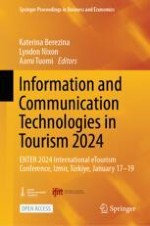1 Introduction
2 Literature Review
2.1 Social Media Marketing
2.2 Instagram Marketing in Tourism
2.3 Influencer Marketing in Tourism
2.4 Perceptions of Online Sources
3 Method
3.1 Measures
4 Results
4.1 Sample Description
4.2 RQ1: How Do Instagram Users Perceive DMOs on Instagram Compared to Travel Influencers?
4.3 RQ2: How Does Participation Influence the Perceptions of Travel-Related Accounts on Instagram?
Influencer | DMO | ||||||
|---|---|---|---|---|---|---|---|
Low | Medium | High | Low | Medium | High | ||
Expertise | MEAN | 4.99 | 5.29 | 5.86 | 6.02 | 5.79 | 6.20 |
SD | 1.51 | 1.27 | 0.95 | 1.02 | 1.31 | 0.99 | |
Trust | MEAN | 5.46 | 5.40 | 5.97 | 3.48 | 4.38 | 5.19 |
SD | 1.33 | 1.08 | 1.13 | 1.20 | 1.13 | 1.16 | |
Attractiveness | MEAN | 5.59 | 5.41 | 5.89 | |||
SD | 1.14 | 1.02 | 1.02 | ||||
Self-Congruity | MEAN | 3.48 | 4.38 | 5.19 | |||
SD | 1.20 | 1.13 | 1.16 | ||||
